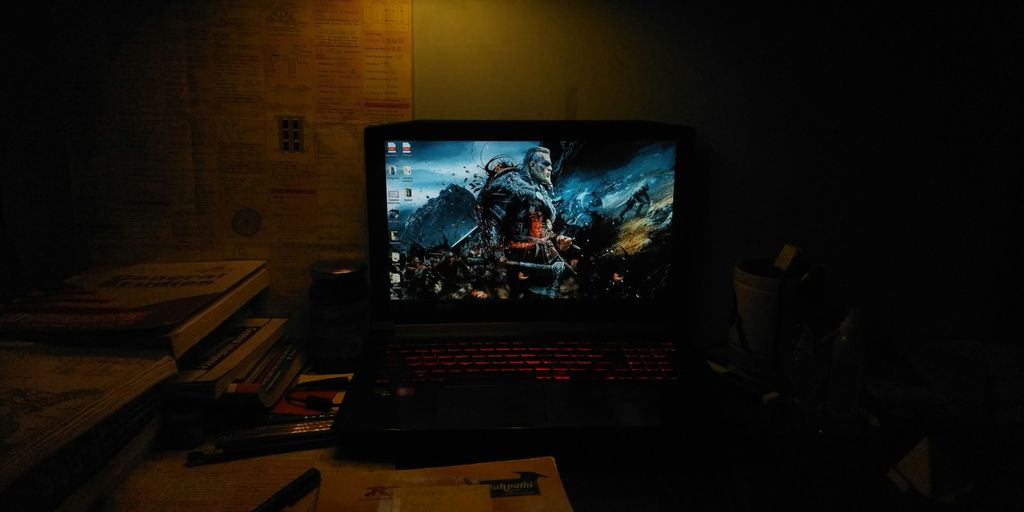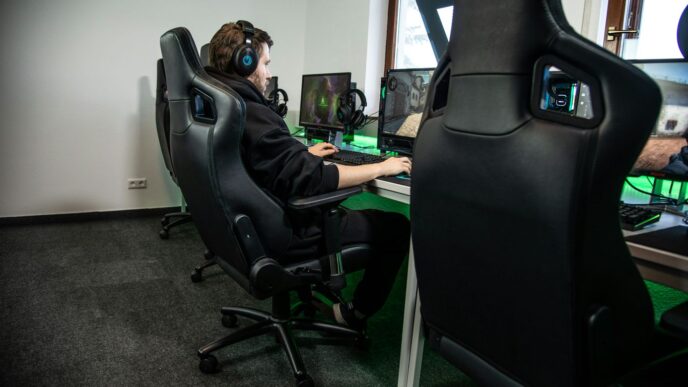Getting the best PC for gaming in 2025 means looking at what makes a computer powerful for playing the latest titles. Games today are way more demanding than they used to be, with super realistic graphics and complex worlds. So, your computer needs to keep up. Whether you’re just playing for fun or trying to go pro, having the right setup makes a huge difference. We’ll break down what you need to consider to find a rig that won’t let you down.
Key Takeaways
- When picking the best PC for gaming, the graphics card (GPU) is usually the most important part for smooth gameplay and good visuals.
- A good processor (CPU) is also key, especially for complex games and multitasking, with Intel Core i7 and AMD Ryzen 5 being solid choices.
- Having enough RAM is vital for multitasking and preventing slowdowns; 16GB is good, but 32GB is better for demanding games in 2025.
- Don’t forget about cooling; high-performance PCs generate heat, so good airflow or liquid cooling is needed to prevent overheating.
- Fast storage, like NVMe SSDs, significantly cuts down loading times, making your gaming experience much quicker.
1. Graphics Card
When you’re building a gaming PC for 2025, the graphics card, or GPU, is probably the most important part. It’s what actually makes the game look good on your screen, handling all those fancy textures and effects. Getting a good GPU means smoother gameplay and higher frame rates, which is what we all want, right?
For 2025, you’ll see a lot of options. NVIDIA and AMD are still the big players, and they’ve got some really powerful cards out. Integrated graphics, like what you find on some AMD Ryzen processors (think the Radeon 780M or 760M), are getting better, but they’re still not quite at the level of a dedicated card for serious gaming. They’re fine for casual stuff or older games, but if you want to play the latest AAA titles at high settings, you’ll need something more.
Here’s a quick look at what to consider:
- Performance Tier: Are you aiming for 1080p, 1440p, or 4K gaming? Higher resolutions need more powerful (and expensive) GPUs.
- VRAM: This is the graphics card’s own memory. More VRAM helps with higher resolutions and more complex textures. 8GB is a good starting point, but 12GB or more is better for future-proofing.
- Ray Tracing: If you want those super realistic lighting effects, look for cards that support ray tracing. It’s a demanding feature, so you’ll need a strong card to run it well.
- Power Consumption and Cooling: Powerful GPUs use more power and generate more heat. Make sure your power supply can handle it and that your case has good airflow.
It’s a bit of a balancing act. You want the best performance for your budget, but you also need to make sure the rest of your system can keep up. Don’t forget to check reviews for specific cards you’re interested in; they’ll give you real-world performance numbers for the games you actually play.
2. Processor (CPU)
When you’re building a gaming PC, the processor, or CPU, is like the brain of the whole operation. It handles all the calculations that make your games run smoothly. It’s easy to get caught up in just looking at clock speeds or the number of cores, but it’s a bit more complicated than that. Think of clock speed like the engine’s RPMs – higher isn’t always better if the engine itself isn’t efficient. Different processor architectures handle tasks differently, so a CPU with a slightly lower clock speed but a better design can actually perform better.
The sweet spot for most gamers is a balanced CPU that offers a good mix of core count, clock speed, and cache size. Too few cores, and you might struggle with newer, more demanding games or multitasking. Too many cores, especially if they’re not utilized by the game, can be overkill and just cost more. Cache, particularly L3 cache, is also important because it’s a small amount of super-fast memory right on the processor that helps speed up access to frequently used data. AMD’s Ryzen processors with "3D V-Cache" technology have shown how much of a difference a larger cache can make, especially in certain games at lower resolutions.
Here’s a quick rundown of what to consider:
- Core Count: For gaming, 6 to 8 cores is generally plenty for most titles. If you do a lot of streaming or video editing alongside gaming, you might consider more.
- Clock Speed: While not the only factor, a higher clock speed (measured in GHz) generally means faster processing. Look for CPUs with boost clocks that can reach 5.0 GHz or higher for a good experience.
- Cache Size: More cache, especially L3 cache, can lead to better gaming performance. AMD’s X3D chips are a prime example of this.
- Architecture: Newer architectures from Intel (like Meteor Lake or Arrow Lake) and AMD (like Zen 4 or Zen 5) are more efficient and perform better per clock cycle than older ones.
For 2025, you’ll see options like Intel’s Core Ultra series and AMD’s Ryzen 9000 series. For most gamers, a mid-range CPU like an Intel Core i5 or AMD Ryzen 5, or a higher-end Core i7 or Ryzen 7, will provide excellent performance without breaking the bank. If you’re gaming at 4K, your graphics card will often be the bottleneck, making a slightly less powerful CPU perfectly adequate.
3. RAM
When you’re building a gaming PC for 2025, RAM, or Random Access Memory, is a pretty big deal. Think of it as your computer’s short-term memory. It’s where the system stores all the data it’s actively using, like the game you’re playing, the apps you have open, and the operating system itself. If you don’t have enough, things can get slow and choppy, which is the last thing you want when you’re in the middle of a boss fight.
For 2025, the minimum amount of RAM you should be looking at is 16GB. Honestly though, most modern games are starting to ask for more, so 32GB is really the sweet spot. It gives you plenty of breathing room for demanding titles and multitasking. DDR5 is the newer standard, and while it’s faster, it can also be more expensive. DDR4 is still perfectly fine for many setups, especially if you’re on a tighter budget. Many motherboards these days can automatically adjust RAM speeds, so you can often pick RAM that matches what your motherboard supports. Just keep in mind that faster RAM usually costs more.
Here’s a quick rundown of what to consider:
- Capacity: 16GB is the bare minimum, but 32GB is highly recommended for a smooth gaming experience in 2025.
- Type: DDR5 is the latest and fastest, but DDR4 is still a solid, more budget-friendly option.
- Speed (MHz): For DDR4, aim for 3200-3600MHz. For DDR5, 5200-6000MHz is a good target.
- Latency (CL): Lower latency is generally better, but don’t stress too much about it if it means sacrificing capacity or speed.
Getting 32GB of RAM will make a noticeable difference in how smoothly your games run. It’s one of those upgrades that really pays off in terms of overall performance and responsiveness.
4. Cooling System
Keeping your PC cool is pretty important, especially when you’re pushing it hard with games. If things get too hot, your parts can slow down, or worse, get damaged. You’ve got a couple of main ways to keep things chill: air cooling and liquid cooling.
Air cooling uses heatsinks and fans. They’re usually simpler and cheaper. Think of a big metal block with fins, with a fan blowing air over it. It works well for most setups, but for really high-end gaming rigs, it might not be enough.
Liquid cooling, or AIO (All-In-One) coolers, use a pump, radiator, and fans. They move heat away from the CPU using a liquid. These tend to be more effective at keeping temps down, especially for overclocking or really powerful processors. They can also look pretty slick inside your case.
When you’re picking a gaming PC, check what kind of cooler it comes with. Some CPUs come with a basic cooler, but often, for serious gaming, you’ll want something better. A good cooler means your CPU can run at its best for longer periods.
Here’s a quick look at what to expect:
- Stock Coolers: Often included with CPUs. Good for basic use, but can get loud and less effective under heavy load.
- Aftermarket Air Coolers: Bigger heatsinks, better fans. Offer a good balance of performance and price.
- AIO Liquid Coolers: Generally the best for keeping high-end CPUs cool. Come in various radiator sizes (120mm, 240mm, 360mm).
Don’t forget about case fans too! They help move air through the whole system, pulling in cool air and pushing out hot air. Good airflow makes all the difference.
5. Storage
When you’re building a gaming PC, storage is a big deal. It’s not just about how much stuff you can fit on your drives, but also how fast you can get to it. Nobody wants to stare at a loading screen for ages, right?
For gaming, you’ll mostly be looking at two types of storage: Solid State Drives (SSDs) and Hard Disk Drives (HDDs). SSDs are way faster, which means quicker game loads and less waiting around. HDDs are slower but cheaper, so they’re good for storing lots of games or other files you don’t access all the time.
Most gamers today aim for an SSD as their primary drive for the operating system and their most-played games. You can always add a bigger, slower HDD later if you need more space.
Here’s a quick rundown of what to consider:
- NVMe SSDs: These are the fastest SSDs you can get. They plug directly into your motherboard and offer super-quick speeds. If your budget allows, this is the way to go for your main drive.
- SATA SSDs: Still much faster than HDDs, these use a different connection. They’re a good middle-ground option if NVMe is too pricey.
- HDDs: Best for bulk storage. Think of them as digital filing cabinets for your game library or media files.
When picking out drives, pay attention to the read and write speeds. Higher numbers mean faster performance. For example, a good NVMe SSD might have read speeds of 7,000 MB/s or more, while a typical HDD might be around 150 MB/s. That’s a huge difference!
6. Build Quality and Design
When you’re dropping serious cash on a gaming PC, you want it to look good and feel solid, right? It’s not just about what’s inside; the case itself matters. Think about it – this is the thing that’s going to sit on your desk, probably for years. You want something that doesn’t feel like it’s going to fall apart if you accidentally bump it. Some cases are made with flimsy plastic that flexes way too much, and others have sharp edges that are just asking for trouble.
The best gaming PCs in 2025 will feature sturdy metal construction, thoughtful airflow design, and a look that fits your setup. We’re seeing a trend towards cleaner aesthetics, with tempered glass side panels to show off the internals, but also more robust materials for the main chassis. Cable management is another big one. A PC that’s easy to build in and keep tidy inside makes a huge difference, not just for looks but for airflow too.
Here’s what to look for:
- Materials: Look for steel or aluminum chassis. Avoid thin, easily dented metal.
- Airflow: Mesh front panels and plenty of fan mounts are key to keeping those powerful components cool.
- Cable Management: Features like routing holes, tie-down points, and space behind the motherboard tray make a big difference.
- Port Accessibility: Easy access to front USB ports and audio jacks is super convenient.
- Durability in Shipping: Some companies are really stepping up their game here, using better packaging to prevent damage during transit. We saw one example where a PC arrived in a wooden crate, which is pretty serious protection. Others just use basic cardboard and foam, which isn’t always enough.
Don’t forget about the little things, like dust filters that are easy to clean. Nobody wants to spend hours taking their PC apart just to get rid of dust bunnies.
7. ASUS ROG

When you think about gaming PCs, ASUS ROG, or Republic of Gamers, often comes to mind. They’ve been in the game for a while, building a reputation for making some pretty solid machines. For 2025, they’re continuing that trend, focusing on giving gamers what they want: performance and a bit of flair.
ASUS ROG systems usually pack the latest hardware. We’re talking about the newest graphics cards from NVIDIA and AMD, paired with powerful Intel or AMD processors. They tend to put these components in cases that look good and are designed to keep things cool. You’ll often see RGB lighting, custom cooling solutions, and generally a build that feels premium.
Here’s a quick look at what you might find in a typical ASUS ROG gaming desktop:
- High-end Graphics Cards: Expect NVIDIA GeForce RTX 40-series or AMD Radeon RX 7000-series cards for smooth gameplay at high resolutions.
- Fast Processors: Intel Core i7/i9 or AMD Ryzen 7/9 processors are common, giving you plenty of power for gaming and other tasks.
- Ample RAM: 16GB or 32GB of DDR5 RAM is standard, making sure your games run without hitches.
- Fast Storage: NVMe SSDs are a must for quick load times, often paired with larger hard drives for extra storage.
- Effective Cooling: ASUS ROG often uses custom cooling systems, including liquid cooling options, to keep those powerful components from overheating.
ASUS ROG aims to provide a complete, high-performance gaming experience right out of the box. They also offer a range of laptops and components, so if you’re building your own PC, you can often find ROG parts that match your desktop. It’s a brand that generally appeals to gamers who want a powerful machine that looks the part, too.
8. Alienware
Alienware has always been a brand that screams "gamer." They’ve built a reputation for creating some seriously powerful machines with a look that’s hard to miss. Think futuristic, almost alien-like designs that stand out from the crowd. When you’re looking at an Alienware, you’re generally getting a pre-built system that’s meant to perform right out of the box, often packing the latest and greatest components. They tend to focus on high-end performance, so expect top-tier graphics cards and processors.
While they might not be the most customizable option compared to building your own PC, Alienware does offer a few different lines to suit various needs and budgets within the premium gaming space.
- Alienware Aurora: This is often their flagship desktop, usually featuring the most powerful hardware and a design that’s both striking and functional. It’s built for serious gamers who want the best.
- Alienware Aurora R-Series: A slightly more accessible version of the Aurora, still offering great performance but perhaps with a few more configuration options or a slightly less aggressive price point.
- Alienware m-Series (Laptops): If you’re looking for a portable Alienware experience, their m-series laptops are known for packing desktop-level power into a mobile form factor, though they come with a premium price tag.
Alienware’s commitment to a unique aesthetic and high-end performance makes them a go-to for many who want a powerful gaming rig that looks the part. They often include their own software for managing system performance and lighting, adding to the overall Alienware experience. Just be prepared for the price that usually comes with that distinctive branding and performance.
9. MSI

MSI has really carved out a name for itself in the gaming PC market, and for good reason. They consistently put out machines that look good and perform well, hitting a sweet spot for many gamers. You’ll often find their systems packed with solid components, and they tend to have a pretty aggressive aesthetic that many people dig.
When you’re looking at MSI, keep an eye on their different series. The Aegis line, for instance, is known for its compact design and good airflow, making it a popular choice if you don’t want a massive tower. Then there’s the Trident series, which often pushes the boundaries of small form factor gaming.
Here’s a quick look at what you might find in a typical MSI gaming rig:
- CPU Socket Compatibility: MSI motherboards support a range of sockets, with AMD AM5 and Intel LGA 1700 being common for current-gen builds. Older systems might use AMD AM4.
- Cooling Solutions: While many MSI pre-builts come with decent stock coolers like the AMD Wraith Stealth or Intel Laminar RM1, upgrading your cooling is often a good idea for sustained performance, especially if you’re pushing your CPU hard.
- Build Quality: MSI generally uses sturdy cases with thoughtful internal layouts, making upgrades or maintenance a bit easier than with some other brands. They often include RGB lighting, which is a big plus for many gamers.
MSI’s commitment to gaming is clear in their product lines. If you’re looking for a pre-built option that balances performance and style, MSI is definitely a brand worth checking out. You can find a good overview of tested pre-built systems on this resource.
10. NZXT
NZXT has made a name for itself by focusing on clean aesthetics and user-friendly builds, and their pre-built gaming PCs are no different. They tend to lean towards a more minimalist look, which is great if you’re not a fan of all the flashing RGB lights you see on some other rigs.
When you’re looking at an NZXT PC, you’re generally getting a solid machine that’s put together with care. They often use good quality components, and their cable management is usually top-notch, making the inside of the PC look as good as the outside. This attention to detail means you’re less likely to run into issues down the line.
NZXT’s approach often prioritizes a balanced performance that’s reliable for everyday gaming and productivity. They might not always push the absolute bleeding edge with every single component, but what they do offer is a well-rounded system that works well out of the box. It’s a good choice if you want a powerful PC without having to worry too much about picking every single part yourself.
Here’s a quick look at what you might find in their systems:
- Processors: Often feature Intel Core i5/i7 or AMD Ryzen 5/7 series CPUs, good for most gaming needs.
- Graphics Cards: Typically equipped with NVIDIA GeForce RTX or AMD Radeon RX cards, balancing performance and price.
- Storage: Usually includes a fast NVMe SSD for the operating system and frequently used games, sometimes paired with a larger HDD for extra storage.
- Memory: Commonly found with 16GB or 32GB of DDR4 or DDR5 RAM, depending on the model and year.
Wrapping Up Your Search for the Perfect Rig
So, finding the right gaming PC for 2025 really comes down to what you want to do. Whether you’re aiming for smooth 1080p or diving into those super-detailed 4K worlds, there’s a machine out there for you. Remember to think about your budget, the games you play most, and don’t forget about keeping things cool and updated. A good gaming PC is more than just parts; it’s your ticket to amazing virtual adventures. Take your time, do a little research, and you’ll be well on your way to enjoying all the latest games without any hitches.
Frequently Asked Questions
What’s a good price range for a gaming PC?
Think about how much money you want to spend. You can find decent gaming PCs starting around $800, but if you want a really powerful one for the newest games, you might need to spend over $3000. It’s all about what you can afford and what you want to do with it.
Are gaming PCs only for playing games?
Nope! Gaming PCs are super versatile. They’re great for playing games, of course, but you can also use them for other demanding stuff like making art, editing videos, or even coding. If you need a computer that can handle tough jobs, a gaming PC is a solid choice.
How often should I think about upgrading my gaming PC?
Most gamers upgrade their PCs every 3 to 5 years. This really depends on how quickly new games come out and what new technology is available. Sometimes, just swapping out a part like the graphics card or adding more memory can make your PC feel new again.
Can I build my own gaming PC?
Yes, you absolutely can build your own gaming PC! It might seem a bit tricky at first, but it’s a great way to get exactly what you want and often save some money. Plus, you learn a lot about how computers work.
How can I make sure my gaming PC runs its best?
Keeping your graphics card drivers up-to-date is super important. It’s like giving your PC the latest instructions to run games smoothly and make sure everything looks its best. Also, cleaning out dust regularly helps keep things from getting too hot, which makes your parts last longer.
What’s the most important part of a gaming PC?
The graphics card (GPU) is the most important part for gaming. It’s what makes the game look good and run fast. After you pick a good GPU, you can choose a processor (CPU) and other parts that fit with your budget. Think of the GPU as the star of the show!














